Days 158-165: Kalaw & Inle Lake
This is our final entry from Myanmar about the Shan State town of Kalaw and the Inle Lake region.
The town of Kalaw is located above 4000′ in the Shan State hills and was a welcome respite from the heat of the plains. The mist-shrouded hills felt a lot like the area north of the San Francisco bay. There are remnants of the British colonial era in the architecture; even the train station was half-timber style. The non-touristy town made for a relaxing couple of days hiking and sipping tea. This was our favorite city in Myanmar.
We spent a day wandering around town and visited one of the local temples. We also noted a significant increase in the military presence. The military wasn’t the only thing beefed up in the area – the mosquitos were big enough to give Marcus a run for his money. On the walk back from the temple, the kids had gotten out of school and were all over the place. Very young kids playing in the street saw us coming and presented us with freshly-picked flowers. There were no adults around to prompt this behavior, and it was repeated five times on the walk back. We were moved.
We took a day hike to some of the surrounding villages. Our guide was supposed to be the son-in-law of the trekking company owner. But he was layed out by a “bad jackfruit” (and who hasn’t been?), which turned out to be to our good fortune because his substitute was a phenomenal guide.
The hills were full of farms growing many types of produce. There had been a lot of rain before we departed, and hiking through rice fields was a welcome relief from the muddy trails.

Cabbage seemed to be a big crop in the cool climate. With our guide translating, this lady told us she wanted to visit America. We told her we’d put her picture on the internet for lots of Americans to see. The translation came back “My picture will be in America even if I never go.”
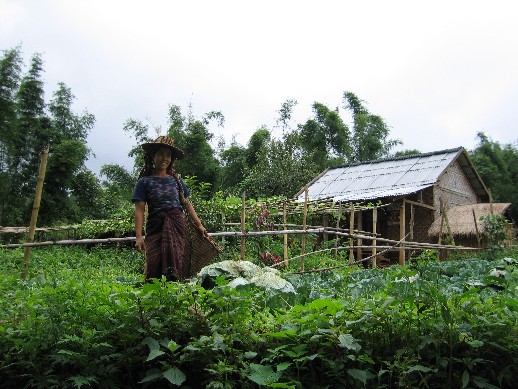
Our guide mentioned that you need to submit a photo of yourself along with the form that allows you to travel outside the country. He asked, in all seriousness, if a computer can tell everything about you when the picture is read into a computer. We assured him it could not. This certainly wasn’t Silicon Valley.
With all of the recent rain, the leeches were out in force. Kelly had one camped out in her shoe but it didn’t bite her (could it have been the smell perhaps?). We pulled out the bug spray to protect our feet and legs (seems to help) but the can was empty. It had emptied itself into one of our bags, and if you know what DEET does to plastic you can imagine that this wasn’t pretty. Adds character though.
We went to a village of the Palang people who grew green tea for a living and wore colorful outfits (that they insisted we try on). Not sure if this photo was a mistake or not.
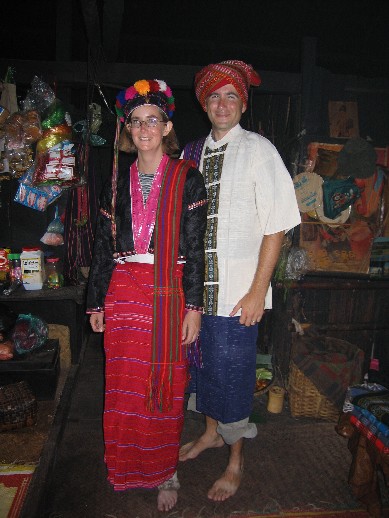
We visited a longhouse in which three Palang families lived. We had lunch and asked them about their livelihood. For dessert they served their locally grown tea and fantastic palm sugar balls that fueled us for the rest of the hike. The men and women work side-by-side in the fields and the spirit of communal cooperation is very strong. When someone needs help harvesting their fields, everybody joins in to lend a hand. We visited on the day before a full moon and everyone was busy preparing for the celebration what would follow a full day of meditating and fasting.
The flora and fauna in the hills was very interesting. The bugs all went into the “Myanmar Critters” entry, but here’s a picture of a cool flower along the trail.
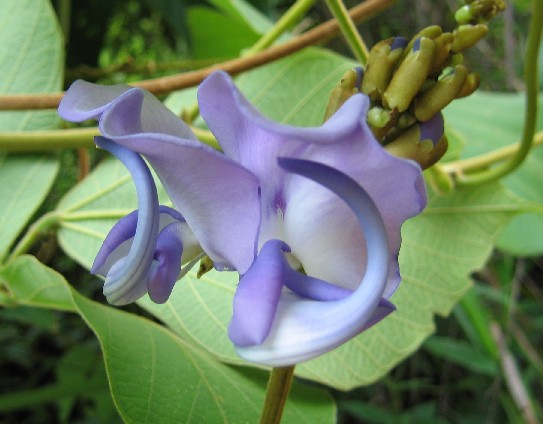
Just before we got back to Kalaw, we came across this “guard dog” protecting an outhouse.
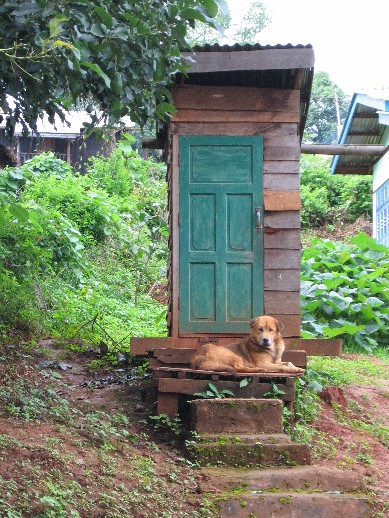
We took a car from Kalaw to Inle Lake with a stop at the Pindaya Caves. These were limestone caves high on a cliff that were filled to the brim with gold-plated Buddha images and devotees paying their respects on the full moon.
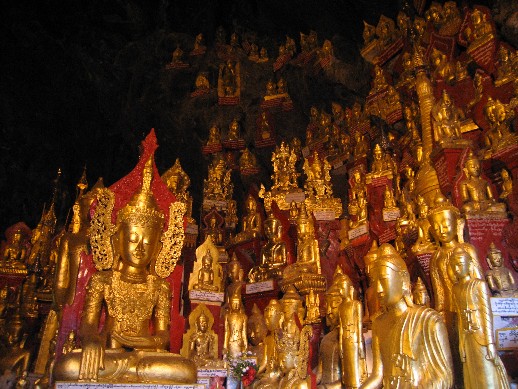
The drive passed through some beautiful countryside filled with cabbage and sunflower farms. Occasionally the streets were lined with small kids standing on huge water buffalos waving at passing cars.

Inle Lake is a large, shallow body of water nestled in a long valley. It is filled with floating orchards which are strips of bouyant matter that have been staked to the lake bottom with bamboo poles. Lots of different types of produce were grown on the floating orchards, but most of it seemed to be tomatoes and corn. There were boats collecting the seaweed that grows on the lake bottom with long poles (is it still seaweed if it grows in a lake?). There were also many fisherman that used conical nets and had an interesting leg rowing style – which Inle is famous for.
One of the leg-rowing fisherman.
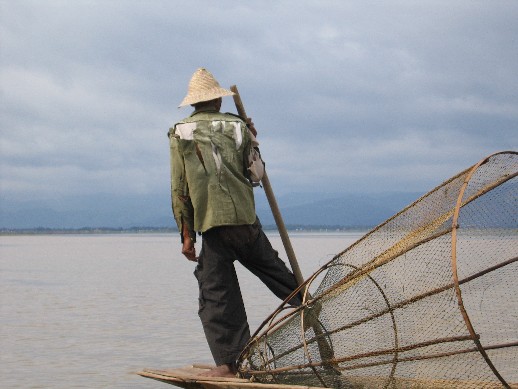
We took a boat trip around the lake and saw many workshops (paper umbrellas, bamboo hats, and “cheroots” which are the local cigar) mainly geared at tourists. Apart from the tourist industry, a lot of the locals went about their daily lives on the lake using good old fashioned canoes to navigate the canals.

We visited a monestary on the lake where monks have trained cats to jump through hoops. And who said it couldn’t be done?
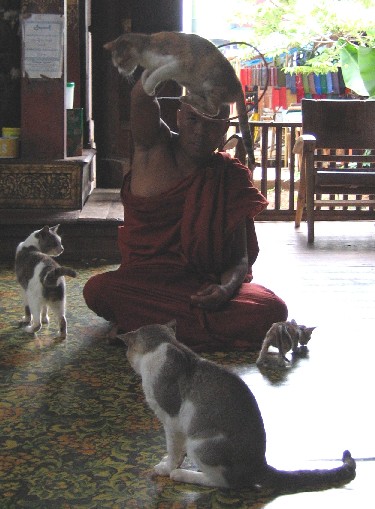
Nice gold Buddha back in the main town (Nyaung Shwe) north of the lake.
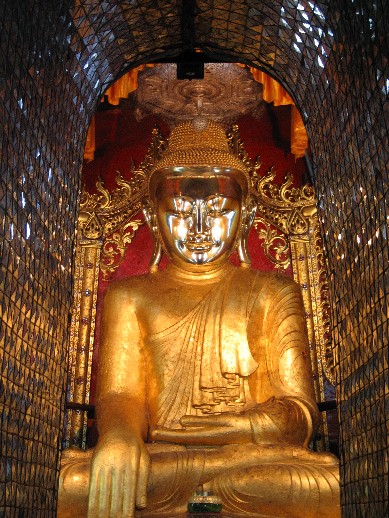
Despite paying for an Indian meal that made us both ill for three days, we went on a hike to the hills east of the lake. Our guide was full of tidbits of knowledge about the various ethnic groups. One of the local groups used to bury their dead by pinning them underneath the floating orchards. We sure hope they don’t still do that because we ate a lot of locally-grown produce. Maybe that Indian restaurant bought some bad tomatoes. Another example was that the women of the Chin tribe would tattoo their faces with a web-like design to make themselves undesirable to the King (who had a habit of taking local women for his harem).
The local hills are inhabited by the Pa-O people, who believe they are decended from the pairing of a holy man and a dragon. This is supposedly why they wear black clothes in many layers to appear like scales. The main industry of these villages was the cultivation of cheroot cigar wrappers. The cheroot cigars were quite popular, even with old ladies. The only vice more popular than cheroot smoking was chewing betel nut, which is supposed to act as a mild stimulant. Unfortunately, it stains the teeth bright red and the ground is covered with red spit.
Drying oven for cheroot leaves. The leaves are pressed with disk weights during drying to keep them flat.
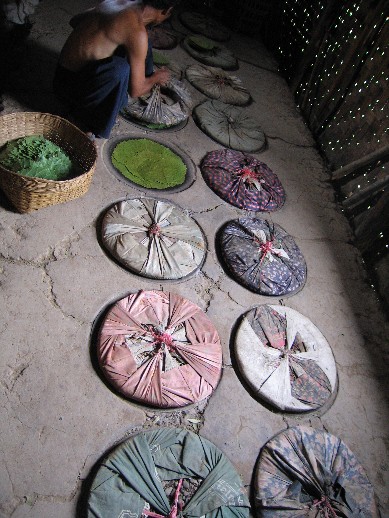
We passed by a boy harvesting young bamboo shoots.
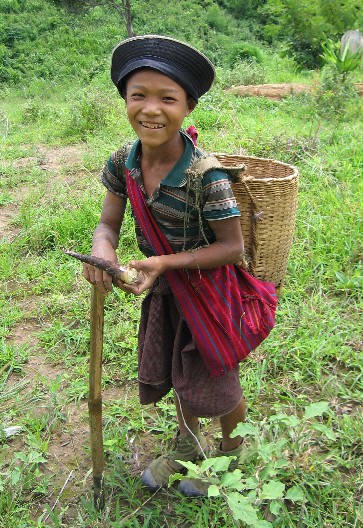
A cute little cowgirl in the hills.
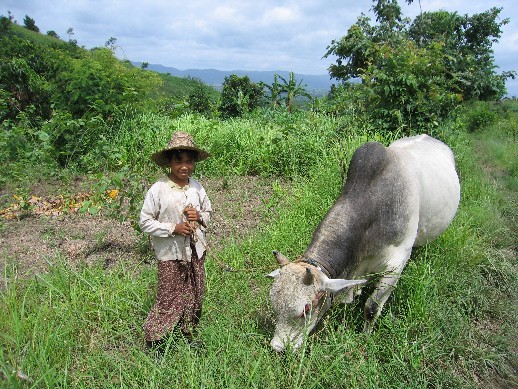
In the main village there were bunches of kids saying “hello” and “bye-bye” interchangibly. They didn’t know that these greetings are only said once. It was cute.

Maybe this is why everyone was so helpful?
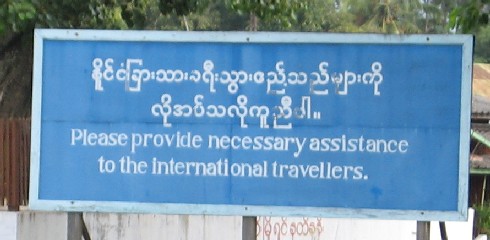
There are local markets that rotate between towns on the lake and the Nyaung Shwe market was quite popular. Here’s a typical stall at the market. Notice the old-style scale that uses disk weights for measuring produce.
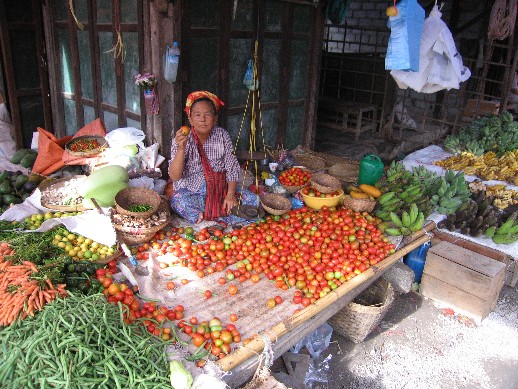
The lake was also used to transport large quantities of rice.

This lady was transporting rice to a processing facility where they beat the rice grains from their husks by hand.
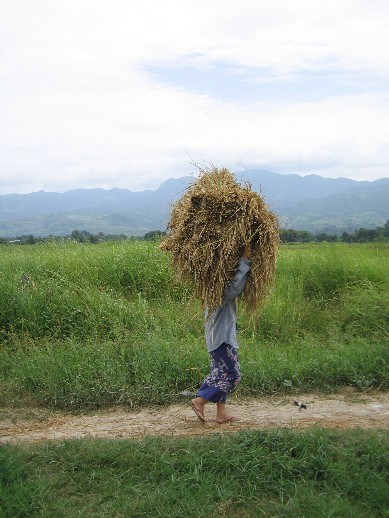
These gorgeous lotus flowers were all over Inle Lake.

We caught a night bus back to Mandalay and flew to the border town of Tachiliek after a couple of days. Tachiliek is in the heart of the Golden Triangle and has quite a bustling trading scene. A guy selling cigarettes offered Marcus “Marlboros?”, “No, I don’t smoke.”, “Marlboro Lights?” He then offered Marcus porn DVDs with Kelly standing right next to him. Nice. At the border there were two signs right next to each other. One proudly proclaimed “City of the Golden Triangle” while the other was in blue and white municipal style and read “Let us all participate in realizing the drug free zone”. As we walked across the border, we watched cars make the transition from driving on the right in Myanmar to the left in Thailand and moved our watches forward a half hour.
Tags: Myanmar

September 2nd, 2005 at 2:23 pm
I can’t tell you how much I enjoy your blogs. I don’t go much but with these I am having a reral adventure